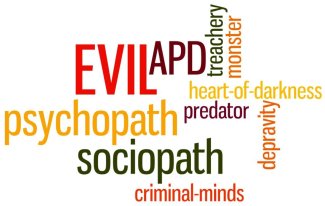Criminal Minds:
The Predatory Mind
Here's an enlightening view into the heart of darkness: the treachery of criminal minds, what tricks might be up a predator’s sleeve, and quite possibly how to beat him at his own game.
WHAT IS EVIL?

The American Psychiatric Association has spent thousands of hours exploring what evil is, why some people revel in it, and how to prevent it. They have a "Depravity Scale" to gauge a criminal's degree of evil, such as depriving victims of their humanity, needlessly escalating a victim's trauma, humiliation, suffering, and terror.
PSYCHOTIC - LEGALLY INSANE
Psychotic symptoms include delusions (“hearing voices” and/or seeing hallucinations), usually exhibiting unpredictable, often frenzied behavior, and not knowing right from wrong. They don't hide their crime thus are legally insane in most U.S. states – from the 1843 McNaughton ruling (a more recent exception: “unable to comply with the law by reason of mental defect”). Psychosis (or psychotic disorder) is a fundamental mental derangement, such as schizophrenia, characterized by defective or lost contact with reality.
(If they do try to hide their crime, that proves they knew it was wrong but did it anyway, thus they're not legally insane.)
According to Indianapolis police Captain Robert L. Snow, author of Protecting Your Life, Home, and Property, one extreme psychotic killed a cop then was shot nine times while still maniacally trying to kill a second cop until a tenth bullet shattered his pelvis and kept him on the ground.
[One way for an unarmed victim to survive such an attack is to “outcrazy” the attacker. Fight fire with fire by unleashing your “animal within” (see Optimal Mindset). Fight with the utmost ferocity and the most brutal of Fighting Options, such as blinding and crippling him - then escaping.
That may seem preposterous, but what other tools do you have? Time and again, victims with no tools almost prevailed but their efforts fell just a bit short. Just in case, learn these simple but powerful fighting options. Even if you lose after all – going out with a roar rather than a whimper – at least you give yourself a fighting chance. Besides, you may well win. See Acting.]
Duke medical sociologist Dr. Jeffrey Swanson says, "Violence-prone people with mental illness are three times more likely to become violent when provoked, but most people with mental illness are not violence-prone.”Though most rampaging mass-murder shooters are psychotic, mass murders are statistically rare. However, alcoholic or drug-addicted psychotics are four times as likely to commit a violent crime than the average person. In contrast, “clean” psychotics are only 1.2 times the average risk. Overall, they comprise less than five percent of all violent offenders. Most simply aren’t capable of the coherent cunning of a predatory criminal’s stealthy hunting and trapping.
News media often cover a hothead who kills in a moment of passionate emotion. Most humans are capable of doing so if pushed to the brink. Such a criminal is contrasted with the “coldblooded” predator who kills with little or no emotion – a small but significant portion of the general public – the psychopath:
PSYCHOPATH - LEGALLY SANE
Roughly one percent of the general public are clinical psychopaths and 10-25 percent are sub-clinical psychopaths. Most of them do not commit actual crimes but do go through life abusing others without guilt. (There’s a far higher percentage of psychopathy among both violent and non-violent criminals.)
The world's foremost authority on psychopathy, Professor Robert D. Hare of the University of British Columbia, says that psychopaths don’t feel positive emotions – much like Mr. Spock or Data on “Star Trek.” Most conventional treatment for psychopathy, such as group therapy, only makes them worse; it teaches them how to better manipulate people and fake emotions.
Experts say that psychopaths, while having an extreme mental disorder, are legally sane – they know right from wrong but commit a crime anyway. By trying to hide their guilt, they prove they knew it was wrong – thus they are sane per the law's McNaughton Rule.
A psychopath’s brain has a dysfunctional amygdala (the center of compassion, fear, sexual orientation, etc.) combined with a dysfunctional Prefrontal Cortex (the ‘executive power center’ that regulates impulse control, emotions, pro-social behavior, and moral judgement). A psychopath’s brain is hyper-sensitive to his reward and hypo-sensitive to the suffering of others – making a psychopath very dangerous.
Psychopathic symptoms include a core, aggressive narcissism and being psychically isolated from other people. They believe they’re entitled to do whatever they want. Psychopaths lack compassion like someone born blind lacks eyesight. They lack a conscience, thus never feel guilt or loyalty. Without compassion for others – the essence of humanity – they blithely deceive and harm those who trust them.
However, though most criminals are psychopaths (at least sub-clinical), not all psychopaths are criminals - most never commit an actual legal crime. Most psychopaths [a.k.a. pathological or malignant narcissists or having narcissistic personality disorder (NPD)] don't have violent criminal minds. A few examples: social or workplace bullies, swindlers, tyrannical bosses, promiscuously unfaithful lovers, and (knowingly) disease-infected sex partners. They wreak havoc but rarely go to prison.
Most psychopaths (both the full-blown clinical and the sub-clinical)
succeed in the military, business (salespeople, lawyers,
corporate executives, etc.), or politics – or anywhere cunning, ruthless ambition
thrives. [To clarify - those occupations have more psychopaths than usual but still, the vast majority of people in those occupations are not psychopaths.]
To a lesser degree, most people are basically self-centered but the extreme psychopath is the ultimate selfish brat grown up into a pitiless, cold-hearted adult. Beware of workplace psychopaths – your boss or a coworker, the New Scientist magazine warns. They may not be violent but their predatory personalities help them rise in rank. Professor Robert Hare says that workplace psychopaths are ruthless, manipulative, and charming – the very traits that help them rise in rank but can also harm those companies. They also make coworkers miserable with their rages, blaming others for their mistakes, and taking credit for others' work.
[However, many of the sub-clinical psychopaths are benign, perform well under pressure, and are an asset to society. See more of the spectrum on What it's like living as a female psychopath.]
The Psychopathy Check List (PCL)
Dr. Hare originated the Psychopathy Check List (PCL). It has 20 questions and scores answers at 0, 1, or 2 points – with 40 points maximum. Serial killers score in the 26-40 range, and are considered “true” full-blown clinical psychopaths. Most violent prisoners score above 20. Most people ("ordinary" people) score 0-5. Scores of 6-25 are considered “sub-clinical psychopaths” (who may comprise up to 25% of the general population).
Psychopathic killers often find great pleasure in torturing victims. Some scientists consider them evil - in that their diabolical savagery has no psychological explanation. Dr. Hare said, “There are some who are psychopathic, sadistic, and sane – for whom evil acts are no big deal.”
The 20 traits assessed by the PCL-R score are: glib and superficial charm, grandiose self-worth, need for stimulation, pathological lying, cunning and manipulativeness, lack of remorse or guilt, shallow affect (superficial emotional responsiveness), callousness and lack of empathy, parasitic lifestyle, poor behavioral controls, sexual promiscuity, early behavioral problems, lack of realistic long-term goals, impulsivity, irresponsibility, failure to accept responsibility for their own actions, many short-term romantic or marital relationships, juvenile delinquency, revocation of conditional release, criminal versatility.
The psychopaths who are violent
– from battering spouses and petty thugs
to serial rapists and serial killers – score somewhere between 6 and 40
on the PCL.
However, though all psychopaths
are ruthless to varying degrees and in various ways, most who score between 6 and 40
on the PCL are not violent criminals and instead harm innocent folks in non-violent ways, oftentimes “legally.”Almost all psychopaths are masters of deception, carefully creating and then preserving their images. The
positive first impressions they make are long-lasting because we trust
our initial judgments and want to believe whatever supports our first
impression, and reject whatever doesn't (a.k.a. “confirmation bias”). If we doubt anything, the psychopath has a smooth explanation to cover it and innocent folks tend to believe them.
Psychopaths seem to have another shared quality, though it's not on Dr. Hare's PCL nor can it be measured. Their eyes are different. The extreme psychopath's gaze has often been described as creepy, cold, empty, reptilian - not quite human. But, of course, that's a matter of opinion.
Researchers Delroy Paulhus and Kevin Williams identified The Dark Triad of Personality: narcissism (entitled self-importance), Machiavellianism (strategic exploitation and deceit) and psychopathy (callousness and cynicism). They show that most ordinary people have at least a few of those traits. But only a few. That dovetails nicely with Dr. Hare’s PCL test showing that ordinary people score from 0-5 on the PCL scale of 0-40.
Extreme psychopaths cannot feel compassion or guilt. They can charm when needed, and they can ruin people's lives on a whim as easily as killing a fly. They're extremely selfish. They cannot change and can actually control psychotherapists trying to diagnose and change them. As just one example of many: Paul Beart was convicted in England of a brutal rape and sentenced to five years. He quickly convinced prison staff that he was fit and was released two years early. He soon raped and murdered Deborah O'Sullivan, a random stranger.
Nature and/or Nurture – What Influences These Predators?
The traditional nature/nurture theory says that your behavior is roughly a 50/50 mix of nature (your genes) and nurture (your parental/societal influences).
The general public often confuses the terms sociopath and psychopath. Sociopathy is caused by poor parenting and/or life influences - unfortunate nurturing. Psychopathy is caused by congenital anomalies in the brain’s amygdala and prefrontal cortex - unfortunate nature.
A sociopath is defined as having a rogue attitude, behavior, and moral code shared by their social group – usually a street gang, ethnic faction, religious sect or cult, political group, or element – that rejects the laws and morals of the larger society in which they reside.
Basically, sociopaths are made ruthless - by unfortunate nurture. Psychopaths are born ruthless - by unfortunate nature (and might also receive unfortunate nurture - for a double whammy). Psychopaths can never become compassionate; their brains aren't wired for it. But sociopaths might someday change their beliefs and leave their gang or cult and reform themselves into good citizens.
Psychopaths comprise up to 25% of U.S. prisoners, and up to 4% of the general population and are “clinical” cases in the 26-40 PCL range. But many more are in the still-dangerous 6-25 “sub-clinical” PCL range.
Since a psychopath’s main defect is “concealed” – with an absence of easily readable signs – its diagnosis is controversial. Thus, psychopathy is not included as a disorder in the Diagnostic and Statistical Manual of Mental Disorders (DSM) of the American Psychiatric Association. Instead, the more general Antisocial Personality Disorder (APD) diagnosis is often applied to criminals who blithely commit a broad range of aggressive crimes.
The new science of neurocriminology is not an either/or choice of nature vs nurture, but a more complex nature/nurture MIX of how our genes and brain structures interact with our social environment. This is called epigenetics: the way one's environment affects the expression of one's genes and brain structure.
Some idealists argue that psychopathic criminals aren’t fully responsible and therefore deserve to be locked up only until they’re “cured” rather than being locked up forever as a permanent danger to others. But realists argue that there’s no “cure” for violent psychopaths - it’s impossible - though they’re master con-artists who often fool the examining psychiatrist.
MONSTERS are MONSTERS - EVIL is EVIL
Here's the bottom line to all this psychobabble: The age-old but accurate diagnoses of “moral insanity” or "malignant narcissism" for violent, predatory minds has been discarded in favor of the modern but slippery terms of psychopathy, sociopathy, and APD. Yet to their victims, these monsters are monsters and evil is evil – the end result is the same no matter the name. Their depravity leaves you with the same Victim’s Options.
MIRROR IMAGING - DON'T DO IT
Many compassionate Pollyannas make the foolish mistake of “Mirror Imaging” – projecting their own values and beliefs onto predatory minds, believing that violent predators are merely helpless victims of tough lives who simply need a helping hand (and that they can reason with or compassionately connect with a predator).
Yet most people who’ve had tough lives have not chosen to be violent predators [such as the siblings of serial killers (raised in the same household) or those born with the same biological disorder or brain defect]. Being dealt a bad hand in life may help explain why callous predators have twisted minds, but excuses nothing. A tough life simply is not a valid excuse for committing a crime, otherwise millions more people with hard-luck stories would have an excuse to wreak havoc. Most poor people and most people who’ve had a troubled childhood and most people born with the same biological disorder or brain defect do not commit violent crimes.
A criminal – who knows the difference between right and wrong – still chooses to do wrong. It's not the fault of society's laws; it's the fault of the lawbreaker.
Furthermore, anyone who has once chosen to be an evil monster can never be trusted to be free ever again among the general public. Freeing a proven monster is gambling with the lives of innocent people who did not volunteer to be guinea pigs.
Though all criminals prey on others, only a minority of them choose to become violent predators. They are not to be pitied – their victims are. They callously choose to inflict harm on others, either for personal gain or for the twisted thrill of a godlike power of life and death.
A veteran New York City undercover cop said, “There are predators who're thrilled by their victims' pain and crying and begging. They love it.”Cruelty to animals eventually leading to cruelty to other humans has been well-documented for centuries. Professor Frank Ascione's studies at Utah State University have shown that most violent and sexual offenders had a history of childhood animal abuse.
For just one of many examples, Australian serial killer Paul Denyer's childhood progression from slashing his sister's teddy bears (destroying something that someone loves), to a kitten's throat, to his eventual murders as an adult was a classic case of animal abuse escalating to serial killing. Veterinarians in New Zealand and Britain are legally allowed to report animal cruelty but Australian and US veterinarians cannot.
Past behavior is the best predictor of future behavior. Anyone who can be cruel to an innocent human or helpless animal that provides unconditional love, is beyond troubled – they are incurably evil.
Serial killer Keith Hunter Jesperson said there wasn't much difference between killing a cat and killing a person, except it was easier to kill a person – they fought back feebly. He said when you have your hands around the throat of a puppy, cat or human, you get to be God. There was no greater thrill for him than that.
Russian serial killer Alexander Pichushkin said he didn't take money or jewelry from his victims. “I didn't need it. I took the most valuable thing, human life. I felt like God.”
These devils-in-disguise are the fiends and monsters of legend. Chameleon-like, they manipulate their prey to gain life-and-death control over them and delight in their victim’s begging for mercy and cowering in fear.
“It cannot be called ingenuity to kill one’s fellow citizens. By these means one can acquire power but no glory.”- Excerpted from The Prince by Niccolo Machiavelli – 1513
FIGHT FIRE WITH GREATER FIRE
A predator commits appalling crimes, but almost always chooses easy targets and uses sly lures to his traps, then launches sneaky attacks. He ensures his total domination by leaving little, if anything, to chance.
Sure, he may seethe with anger and even welcome token resistance to further his sadistic pleasure, but nevertheless he carefully avoids any real challenge to his total control over a defenseless victim. “They never go after weightlifters,” said former FBI agent Robert Ressler - co-author of Whoever Fights Monsters and an expert on the twisted minds of serial killers. A truly brave man is too proud of his self-image and respected reputation to behave so cowardly by choosing easy targets.
Ultimately, the psychological profiles of predators are much like the pugnacious yet fainthearted schoolyard bullies who've grown older, bolder, and more treacherously evil. And therein is the key to surviving a life-and-death confrontation with them.
You must prevent anyone from getting near you – or isolating you – in a secluded location (as described in Outdoor Safety - Overview). You must act to escape his trap by explosively attacking him (preferably before he attacks you – as described in When to Fight).
Far from a superman, he can be badly injured or even killed (to end his threat to your safety) by your self-righteous fury and the fighting methods in Fighting Options - Overview. You must “go animal!” on him. Adopt a rabid pit bull attitude – imitating the most vicious dog you've ever seen – and become his worst nightmare by attacking him with a maniacal ferocity. When it’s time to “do-or-die,” your will to survive must surpass his will to kill you.
Besides, what other choice do you have? When someone’s trying to kill you, your best bet – your only chance, your only hope – is to not whimper, but to fight with the utmost ferocity. See Optimal Mindset and Self Defense Techniques.
PERSONAL SECURITY DEVICES
Deter a predator by holding Pepper Spray & a Personal Security Alarm (noisemaker or screamer) in plain sight. Those pages tell you how to use them most effectively.
Crime-Safety-Security > Criminal Minds Overview > Predatory Mind









